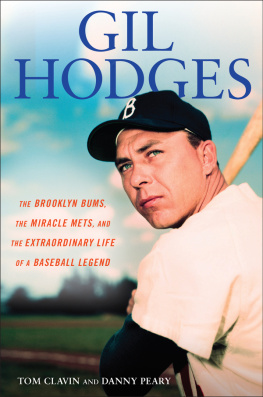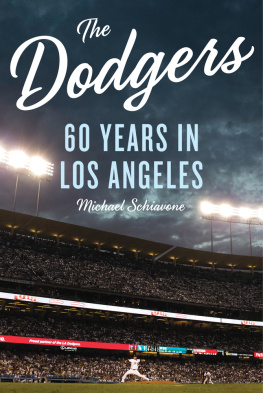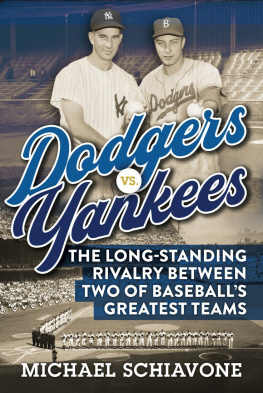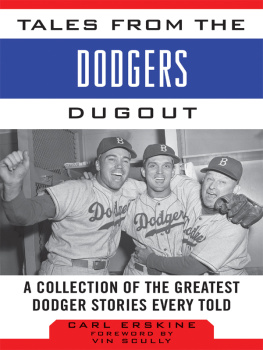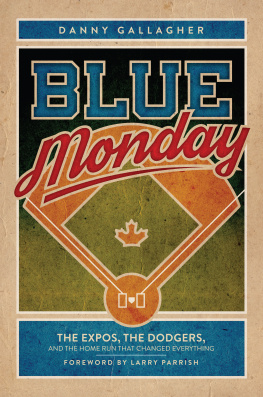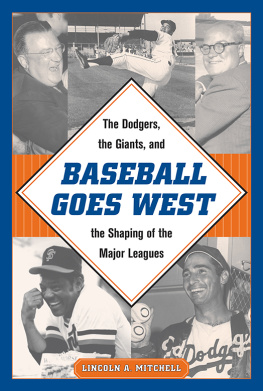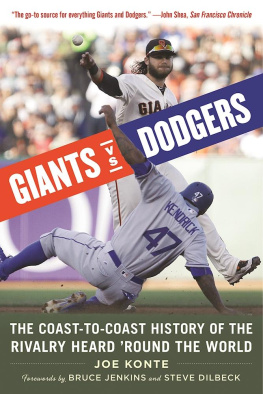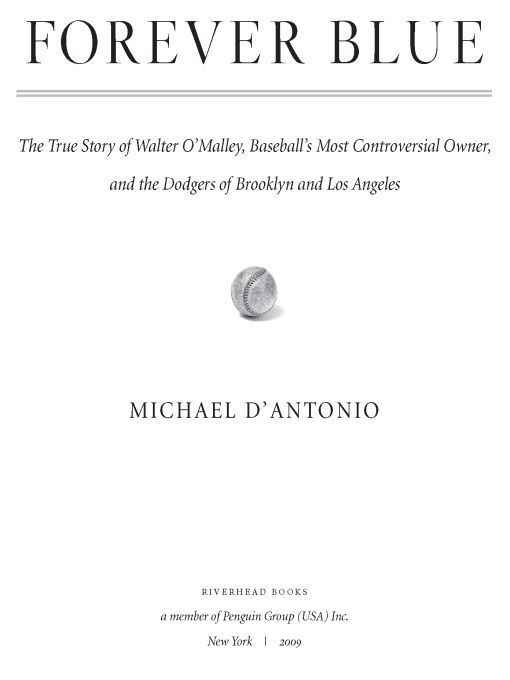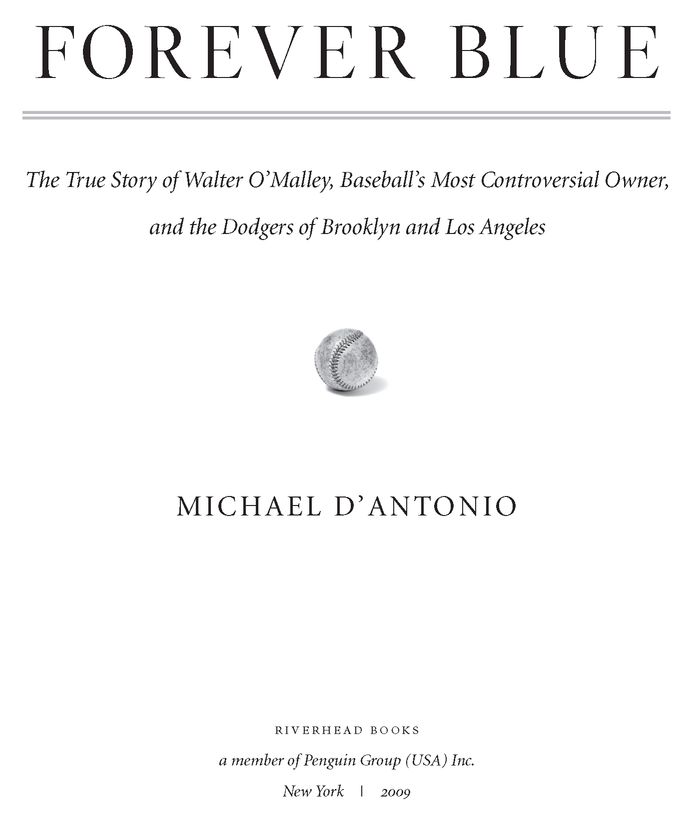Table of Contents
ALSO BY MICHAEL DANTONIO
A Ball, a Dog, and a Monkey: 1957The Space Race Begins
Hershey: Milton S. Hersheys Extraordinary Life
of Wealth, Empire, and Utopian Dreams
The State Boys Rebellion
Tour 72: Nicklaus, Palmer, Player, TrevinoThe Story of One Great Season
Mosquito: The Story of Mans Deadliest Foe (with Andrew Spielman)
Tin Cup Dreams: A Long Shot Makes It on the PGA Tour
Atomic Harvest: Hanford and the Lethal Toll of Americas Nuclear Arsenal
Heaven on Earth: Dispatches from Americas Spiritual Frontier
Fall from Grace: The Failed Crusade of the Christian Right
For Dodgers of every era,
and their fans, forever blue.
Preface
On the night when major-league baseball died in Brooklyn, fewer than seven thousand fans went to the old ballpark in Flatbush to pay their respects. Most sat in the lower level, behind home plate, and along the baselines. In the big empty sections of the grandstand a light autumn breeze blew paper cups and empty peanut bags down concrete aisles and against rows of old slatted chairs. On the field, players moved with the extra weight of knowing that this time there would be no next year. After many seasons of joyin the face of Jackie Robinson, in the bellowing voice of Hilda Chester, and in the roar of standing-room-only crowdsEbbets Field had become a desolate and unhappy place.
The Dodgers beat the Pirates 2-0. Organist Gladys Goodding played Auld Lang Syne as the grounds crew raked the infield and, out of habit, spread a tarp over the pitchers mound. Emmett Kelly, the sad-faced clown who had performed his act before Dodgers games throughout the season, would recall seeing many womenand a few mencrying as they left Ebbets Field for good.
Brooklyn had already entered an era of loss. The daily paper, the Eagle, had died in 1955, and the trolley cars had stopped running in 1956. Several big retail stores and theaters had closed, and young families were moving to the suburbs of Long Island. Now the great Dodgers baseball team was leaving and there was nothing anyone could do about it. For some the wound was so deep and ragged that the pain would never quite disappear. Almost fifty years later, in one of the last interviews he gave before his death, Dodger pitcher Clem Labines voice trembled as he recalled the day and asked, Why did he do it?
He was Walter OMalley, the teams owner, and what he did would go down in history as a betrayal equal, in some minds, to Benedict Arnolds treason at West Point. At a time when people in Brooklyn were fighting to hold on to their optimism and identity, OMalley uprooted the most important symbol of their plucky spirit and moved it to Los Angeles.
In the years since they moved west, the old Brooklyn Dodgers became the subject of more intense worship and hagiography than any ball club in history. The Yankees of Ruth and Gehrig were more worthy of awe and the Cubs have certainly earned the underdog love they enjoy every season. But Frank Sinatra sang of a ballpark in Brooklyn, not Chicago, and only the Brooklyn Dodgers of the 1950s could inspire Roger Kahns The Boys of Summer, which became one of the biggest-selling baseball books of all time.
Kahns elegy, published in 1972 and maintained in print ever since, was followed by an entire genre of Brooklyn Dodgers literature in the form of books, articles, and even academic papers. In many of these works, and more casual remembrances, OMalley is portrayed as a villain. New York writer Jack Newfield famously called OMalley one of the three worst human beings who ever lived. His colleague Pete Hamill, who has published at least twenty books, is known as much for his hatred of OMalley as for anything else. When, in 2007, OMalley was finally voted into the Hall of Fame, Hamill wrote Never forgive, never forget and declared that with his election the hall took all morality out of the honor of getting a plaque at Cooperstown.
But as much as Hamill might disagree, OMalley actually deserved a spot in the hall. With his fateful decision to leave Brooklyn, he did more than anyone to make baseball a truly national game. And during his reign, the Dodgers became one of the greatest franchises in all of sport. From the day he moved to Los Angeles until he died in 1979, OMalleys team would be the best in the National League, winning three world championships and seven pennants and finishing second seven times. (In all of baseball, only the Yankees had a better record.) OMalley also built the first truly modern stadium in America, a gracefully designed ballpark that remains, after nearly fifty years, one of the best places in the world to watch a game of any sort.
Although a few hard cases in Brooklyn would never forgive him, millions of fans in the Los Angeles area came to regard OMalley, who didnt need padding to play the role, as some kind of Santa Claus. They felt this way because he had given them the gift of elite-level baseball and affirmed their citys status as major league. OMalley became so popular in Los Angeles that on the fiftieth anniversary of the teams arrival in the city, a five-foot-high bronze frieze of his image was installed at the Los Angeles Memorial Coliseum Court of Honor. There he joined other sports figuresincluding Knute Rockne, Jackie Robinson, and Jesse Owensdeemed to have contributed to the growth and glory of the city.
THE ANIMUS And the affection heaped on OMalley long after his death raises an obvious question: How could a sportsman be so hated in one place and so beloved in another? The Brooklyn/Los Angeles divide suggests part of the answer, but parochialism does not explain it all. Its important to recall, too, that OMalley was an imposing figure who wielded power over a popular institution and supervised many ambitious and headstrong individuals. Few people ever enjoyed more direct authority than the owner of a ball team in the days before free agency and the players union. This power allowed him to accomplish great things, but it also aroused suspicion, envy, and animosity.
Any attempt to explain OMalley must also consider the gaps in the record of his life. He was not the type who would reflect aloud on his motivations or reveal his innermost thoughts. From the outside anyone could see that OMalley was devoted to his family and that he thoroughly enjoyed his wealth, status, and the trappings of success. But while he lived, he avoided close analysis. This was especially true when it came to events surrounding his acquisition of the team and the move west. Once these struggles ended, he rarely spoke of them in public. He insisted on calling old rivals his friends and usually declined to defend himself against his critics.
Because he was so reticent, anyone depending on the public record would be challenged to understand OMalley, or the moves he made, with any real certainty. Fortunately he left behind a vast archive of personal and business files that help fill in the picture. Made available by his surviving children, these papers became the documentary foundation for this book. They reveal the inside story of OMalleys rise from the son of a Tammany Hall pol to the boss of baseball and place certain historic events in a new light.


